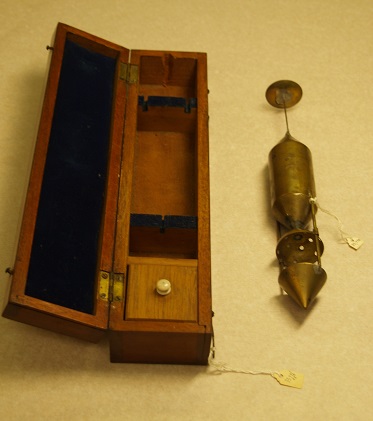Invention #1 - Nicholson’s Hydrometer
January 15th, 2018share this

A hydrometer is a device for measuring a density (weight per unit volume) or specific gravity (weight per unit volume compared with water). It was also called an aerometer, a gravimeter or a densimeter.
On 1 June 1784, Nicholson wrote to his good friend Mr. J. H. Magellan with: ‘A description of a new instrument for measuring the specific gravities of bodies’.
According to Museo Galileo, hydrometers date back to Archimedes and the Alexandrian teacher Hypatia, but the second half of the nineteenth century saw the design of several types which were well-used in industry of which “the better-known models include those developed by Antoine Baumé (1728-1804) and William Nicholson (1753-1815)”.
Nicholson’s paper, which does not seem to be accompanied by a drawing, was published the following year in the Memoirs of the Manchester Literary and Philosophical Society (London: Warrington, 1785) 370–380, and can be accessed via Google Books
In the first edition of Nicholson’s A Journal of Natural Philosophy, Chemistry and the Arts, Nicholson wrote an article about the hydrometers invented by Baumé – one for spirits and one for salts - which had never been used in this country, but never mentioned his own earlier invention.
In June 1797, Nicholson published a translation of a paper that had been read in France at the National Institute by Citizen Louis Bernard Guyton de Morveau (1737-1816), and then published in the Annales de Chimie. Nicholson points out that ‘this translation is nearly verbal’ as he finds himself writing about his own invention.
Comparing Nicholson’s hydrometer with that designed by Fahrenheit which he described as ‘not fit for the hand of the philosopher’, Guyton de Morveau says:
“The form which Nicholson gave some years ago to the hydrometer of Fahrenheit, rendered it proper to measure the density of solids. At present it is very much used. It gives, with considerable accuracy, the ratio of specific gravity to the fifth decimal,water being taken as unity. … It does not appear that any better instrument need be wished for in this respect.”
Of all of Nicholson’s inventions, this one still bears his name and is called Nicholson’s hydrometer today. Examples can be found in several museums, and it is possible to purchase a modern version for use in school experiments for just a few dollars.
The Oxford Museum of the History of Science kindly showed me their Nicholson’s hydrometer from 1790.

Others can be found at:
HarvardUniversity Collection of Historical Scientific Instruments
St.Mary's College in Notre Dame, Indiana
The VirtualMuseum of the History of Mineralogy (Private collection)
Sadly, I couldn’t find a video online with a demonstration of Nicholson's hydrometer being used. If anyone knows of one, or feels the urge to produce one, I would love to share it on this website.
#20

The Life of William Nicholson, 1753–1815
A Memoir of Enlightenment, Commerce, Politics, Arts and Science
Edited by Sue Durrell and with an afterword by Professor Frank James
£13.99
Support independent bookshops, and order a copy from Bookshop.org
Order